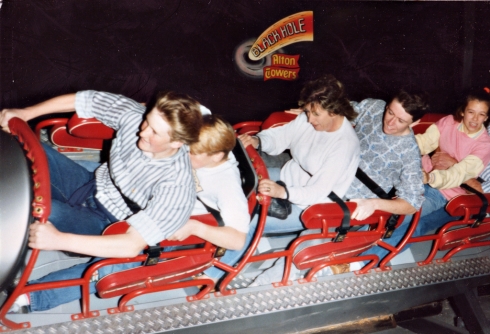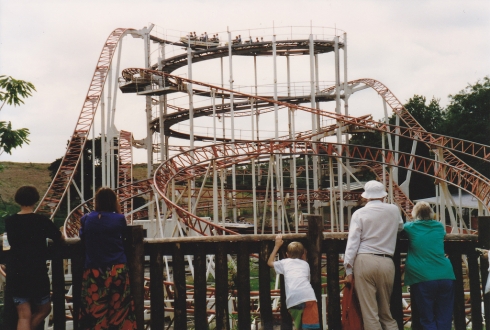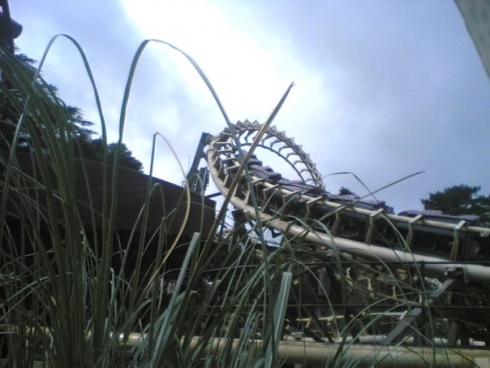
Bermuda shorts. Kylie Minogue. The Goonies. All unforgettable elements of the 1980s - as are these 6 classic Alton Towers attractions from the park's early years.
Alton Towers in the 1980s was a very different place to the current park. Run by eccentric entrepreneur John Broome, the park was regarded by many as being more of a "funfair in the woods" than a "proper" theme park. Broome had a relaxed approach to planning regulations, and brought in many off-the-shelf rollercoasters and flat rides, with little thought given to actual theming.
Still, that didn't stop Alton Towers becoming one of the UK's number most popular tourist attractions, pulling in more than two million visitors per year by the middle of the decade. And for many of those who visited the park during that era, when multiple new rides arrived almost every season, it was something of a "golden age".
A few of the attractions that put Alton Towers on the map are still around today, such as the Pirate Ship (now The Blade). But most are long gone. Let's take a look back at six of the very best.
6. Around the World in 80 Days
Around the World in 80 Days was a custom-built boat ride that has a special place in the hearts of many 1980s children. Clearly inspired by Walt Disney’s It’s a Small World (which had been built for the 1964 New York World’s Fair and then shipped to Disneyland), it saw riders boarding boats before floating through scenes depicting various different countries. Mercifully, it didn’t include the Disney ride’s notorious cutesy soundtrack, but each country did have its own backing song. Among the locations included in the line-up - designed by Keith Sparks’ Sparks Creative Services - were Burma, Egypt, New York, Venice, Greenland, Las Vegas, Vienna, Holland, Rio, Paris and London.
While it was somewhat derivative, Around the World in 80 Days’ detailed scenes were impressive to a UK audience that had mostly yet to be exposed to Disney’s creations. Its popularity was helped two years later, when the cartoon series Around the World with Willy Fog made its television debut, exposing a new generation to the Jules Verne story. Among the ride’s most memorable effects were waterfalls that turned off just before the boat passed underneath them (again borrowed from a Disney ride, this time the Jungle Cruise), a menacing monster that terrified smaller children and set of can-can dancers.
5. Doom & Sons
One unusual attraction that is fondly remembered by many 1980s visitors is Doom & Sons, the “haunted house” that was installed alongside Around the World in 80 Days. Despite being billed by the park as “more fun than scary”, many children begged to differ. Housed inside a building designed to resemble a Victorian-style undertakers, the walkthrough attraction made extensive use of ultraviolet lighting and physical special effects – including smells.
One sign carried the ominous warning “Don’t Look Up”. A dead librarian hung from the ceiling above. Other areas saw guests sinking into the spongy floor, or opening a door (against the “Do Not Open” instruction) to be confronted by a screaming zombie. In another scene, a pair of feet protruded from a burning fireplace.
4. Swan Boats
The iconic Swan Boats ride arrived in 1987, taking up residence in the Ingestre Lake. It was billed as “the only ride of its kind in the world…glides you round the lake in style”. Due to the glacial pace at which they moved, it took some six minutes for the swans to make their way around the course, directed by a series of pulleys. Predictably, this made it a popular make-out spot for teenage couples. Despite being one of the most recognisable rides at the park, it was removed in 2003 and eventually replaced by the Battle Galleons.
3. The Black Hole

Alton Towers marketed 1984's new addition, The Black Hole, as the UK’s equivalent of Space Mountain at Walt Disney World’s Magic Kingdom, which it would resemble both in its space travel theme and its enclosed location. The reality was somewhat less spectacular. Disney’s Space Mountain had been a custom “wild mouse”-style coaster packed with high-tech special effects, built at a cost of $15-20 million in 1975. The Black Hole, meanwhile, was an off-the-shelf Jet Star II model designed by Anton Schwarzkopf, identical to existing coasters at several other parks (the first was built in 1974).
The trains were pulled up a spiralling lift hill towards a model of a spaceman, before plunging down the 27 foot first drop. They then raced through a series of short drops, tight corners and helices before hitting the final brake run. What would have been a relatively tame roller coaster mutated in the pitch black surroundings to become something much more menacing, with guests unable to anticipate the twists and turns. The only lighting came from the few stars and nebulae that comprised the “special effects”.
Brian T. Jones recalls: “I don’t think any coaster after the Black Hole created the same sense of buzz around the school-yard - you were nobody until you rode the Black Hole and proudly showed off your on-ride photo at school. In 1984 it was the Nemesis/Oblivion of its day, but back then, steel coasters were still new so it had a far greater impact on visitors than the later grand rides. And the fact that it was all hidden in the dark only added to its sense of menace.”
2. The Alton Beast

Two new roller coasters arrived at Alton Towers in 1988 - the Alton Mouse and the Alton Beast. The latter was a curious addition. Billed as having “the steepest drop in Britain”, it may have caused feelings of déjà vu for visitors who had already experienced the Black Hole. That’s because it featured a near-identical track layout, being a Schwarzkopf Jetstar III model, the successor to the Black Hole’s Jetstar II. The only small differences were a taller lift hill and an extra drop, and the Black Hole’s old trains were even moved to The Beast following its upgrade to the Black Hole II in 1988. The additional height did enable the Alton Beast it to go a little faster than the Black Hole, hitting a top speed of 44 miles per hour.
1. The Corkscrew

Having decided to convert Alton Towers into a theme park, John Broome needed a major ride to headline it for its first season in 1980. He turned to Dutch firm Vekoma. Founded as a manufacturer of agricultural and mining machinery in 1926, it was by now producing “off-the-shelf” amusement park rides for the travelling funfair circuit in Europe. In the late 1970s, it was making its first tentative steps into the roller coaster market, with the double-looping MK-1200, better known as the Corkscrew. Designed to be put together and taken down quickly, it was also of a relatively compact design. Broome persuaded a group of German financiers to fund the installation of a Corkscrew model at Alton Towers, at a cost of £1.25 million.
The impact on attendance at the park was immediate, with visitor numbers rising from 500,000 per year in the 1970s to just over 1 million in 1980. Awaiting this flood of guests was a roller coaster that would seem relatively tame by today’s standards, but was completely new – and rather intimidating – for the UK public of 1980. After boarding the train and pulling down the over-the-shoulder restraints, riders were carried to the top of a 75-foot lift hill. As they rounded a bend at the top, they were treated to stunning views of Alton village and beyond. Most, though, were pre-occupied with anticipation of the 68-foot first drop that awaited them. Plunging to the bottom of this, the train reached a top speed of 44 miles per hour, before racing around a helix and into the signature double corkscrew element. The remainder of the course was nondescript, with several further turns and helices before it pulled back into the station.
The Corkscrew remained in place for some 28 years, with the only minor change being a slight “retheme” to fit in with the surrounding prehistoric Ug Land area when it was introduced in 1999. In total, it carried over 43 million guests around its circuit before finally being shuttered in 2008.
Want to learn more about Alton Towers' past? Check out Tales from the Towers, the only book that covers the entire history of the park.

Add new comment